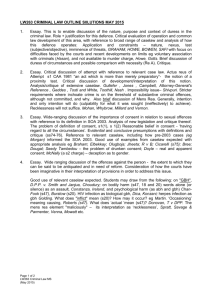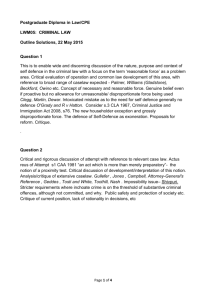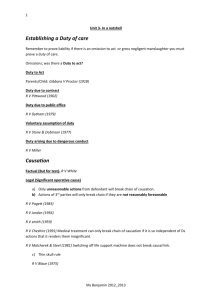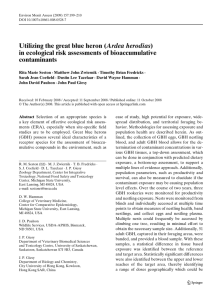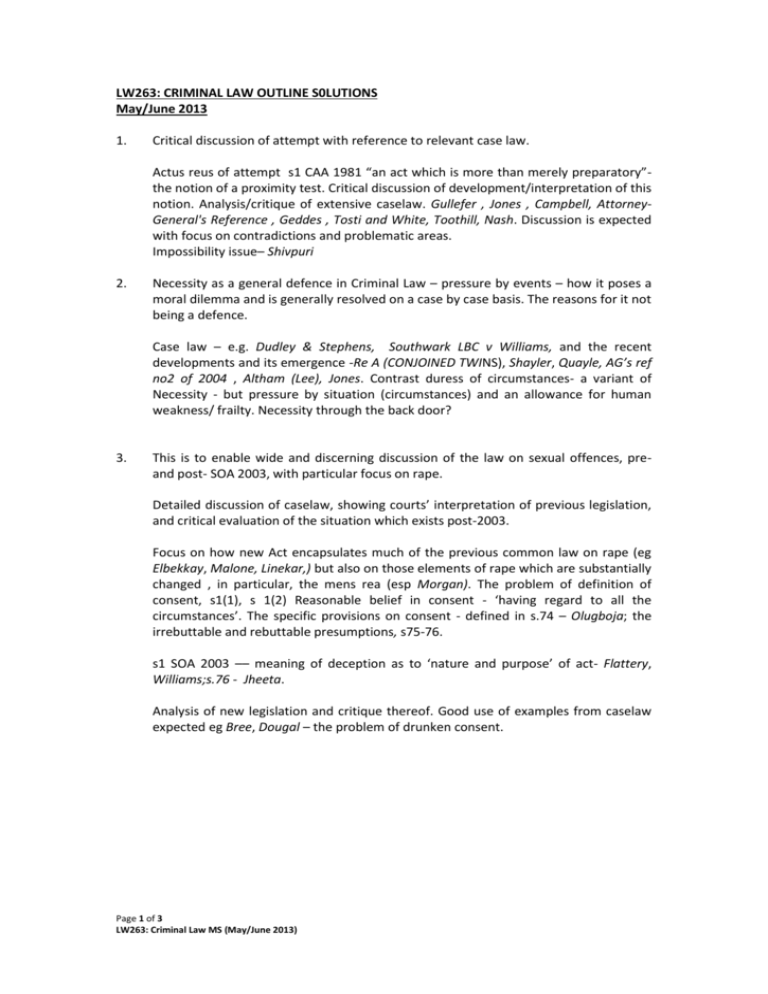
LW263: CRIMINAL LAW OUTLINE S0LUTIONS
May/June 2013
1.
Critical discussion of attempt with reference to relevant case law.
Actus reus of attempt s1 CAA 1981 “an act which is more than merely preparatory”the notion of a proximity test. Critical discussion of development/interpretation of this
notion. Analysis/critique of extensive caselaw. Gullefer , Jones , Campbell, AttorneyGeneral's Reference , Geddes , Tosti and White, Toothill, Nash. Discussion is expected
with focus on contradictions and problematic areas.
Impossibility issue– Shivpuri
2.
Necessity as a general defence in Criminal Law – pressure by events – how it poses a
moral dilemma and is generally resolved on a case by case basis. The reasons for it not
being a defence.
Case law – e.g. Dudley & Stephens, Southwark LBC v Williams, and the recent
developments and its emergence -Re A (CONJOINED TWINS), Shayler, Quayle, AG’s ref
no2 of 2004 , Altham (Lee), Jones. Contrast duress of circumstances- a variant of
Necessity - but pressure by situation (circumstances) and an allowance for human
weakness/ frailty. Necessity through the back door?
3.
This is to enable wide and discerning discussion of the law on sexual offences, preand post- SOA 2003, with particular focus on rape.
Detailed discussion of caselaw, showing courts’ interpretation of previous legislation,
and critical evaluation of the situation which exists post-2003.
Focus on how new Act encapsulates much of the previous common law on rape (eg
Elbekkay, Malone, Linekar,) but also on those elements of rape which are substantially
changed , in particular, the mens rea (esp Morgan). The problem of definition of
consent, s1(1), s 1(2) Reasonable belief in consent - ‘having regard to all the
circumstances’. The specific provisions on consent - defined in s.74 – Olugboja; the
irrebuttable and rebuttable presumptions, s75-76.
s1 SOA 2003 –– meaning of deception as to ‘nature and purpose’ of act- Flattery,
Williams;s.76 - Jheeta.
Analysis of new legislation and critique thereof. Good use of examples from caselaw
expected eg Bree, Dougal – the problem of drunken consent.
Page 1 of 3
LW263: Criminal Law MS (May/June 2013)
4.
Direct and oblique intent compared (students may cite the theoretical “bombed
aircraft” scenario - Hyam). Nedrick, Woollin. Role of foresight explained (“virtual
certainty”). S.8 CJA 1967 – subjectivity of test, intention may depend on D’s
intelligence.
What if D foresees a “virtual certainty” which objectively is not one?
Does “virtual certainty” give a clear distinction between intention and recklessness.
Distinction between motive, desire and intention.
Intention as aim or purpose.
Definition in Mohan.
Law Commission recommendations.
Use of “basic intent” to describe offences that do not require intention.
Problems as in, say, Re A and extremely risky, “last chance” surgery.
5.
Jamie/Chris. Murder? Seemingly no intention to kill/cause GBH (Cunningham,
Moloney), so can only be UDA manslaughter. Elements: Mitchell – unlawful,
dangerous, risk of harm. Unlawful: Lamb, Franklin. Dangerous: Larkin, Church,
Newbury. Foreseeability of harm: Dawson, etc.
Causation: factual (White), legal (Smith etc), novus actus. Refusal of medical
treatment/act of victim (break of causal chain?): thin skull rule Blaue, possibly Dear.
Respect for religious/moral beliefs, “whole person” considered. Is this a “real”
religion?
Kerry/Leo. Murder -Intention to kill or cause GBH. Seems to be direct intent, but need
only be oblique (Nedrick, Woollin).
Causation issues: Legal causation - Is a minor wound an ‘operating and substantial
cause of death’? Cheshire, Smith, Pagett.
Being hit by car as novus actus interveniens; foreseeability issue, Roberts, Lewis;
escape cases.
Poor medical treatment – Jordan, Cheshire – seems to be like latter. Jordan
distinguished clearly on facts. Unlikely to be novus actus interveniens.
Jackie/Leo Gross negligence manslaughter. Elements Bateman test, Adomako. Final
decision as to ‘gross’ – a Q for jury.
Page 2 of 3
LW263: Criminal Law MS (May/June 2013)
6.
C’s liability as to L:
Sexual assault: Sexual offences Act 2003: S3. The problem of consent, s1(1), s 1(2)
‘having regard to all the circumstances’ - Reasonable belief in consent? Also general
definition of consent, s74 – query whether E “agrees by choice,"etc ie submission or
consent? Is stroking of thighs and pinching of bottom sexual? s.78, if sexual by nature,
or because of its nature circumstances/ purpose- R v Price; R v H
Defence: Intoxication - An alcohol/drug fuelled mistake about consent -no defence
prior to 2003: Fotheringham. Does he have reasonable belief that she is consenting?
Liability for taking petty cash; Burglary, Theft Act 1968 s9 (1) (a) entering with intent,
or s9 (1) (b), ‘having entered’,steal; query whether AR and MR present - trespasser,
Collins, Jones and Smith etc. Query whether bar is ‘part of building’ -Walkington. Theft
as an essential element of burglary offence here, so discussion of definition of theft,
TA 68, s1 - elements, dishonesty, s2, Ghosh test, s3, appropriation. Aggravated
burglary: TA 1968, s.10, Charles is carrying a weapon (a knife).
Stabbing of manager; Stab wound serious: s.18 OAPA 1861, (or s20 if required intent
not found): wounding (severe cuts), GBH. On "Wounding", Moriarty v. Brookes ;on
"GBH", D.P.P. v. Smith. On the Specific Ulterior Intent (s18), Belfon . OR s.20 Wilson
.On "maliciously" Mowatt, Savage and Parmenter.
Intoxication as defence: Majewski Voluntary self-induced intoxication is no defence to
offences of "basic intent", whereas it may be sufficient to negative intention for
offences of "specific intent" where D too drunk to be able to from MR: Sheehan and
Moore.
Page 3 of 3
LW263: Criminal Law MS (May/June 2013)

